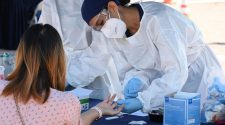Late on Thursday, July 25th, SpaceX launched a test version of its next big rocket from Texas, sending the vehicle hovering in the air for a few seconds before it landed back on the ground. The hardware didn’t get very high, but it was the first time the test vehicle flew detached from the ground, powered by SpaceX’s next-generation rocket engine.
The vehicle is a test prototype of SpaceX’s future, Starship rocket. Starship is the company’s most ambitious vehicle concept yet: it’s a fully reusable design intended to send cargo and people to deep space destinations like the Moon and Mars. Similar to SpaceX’s Falcon 9 rockets, Starship is supposed to land upright — on Earth or on distant worlds — and then be able to take off again.
Starship still has a long way to go before it even gets to space, let alone lands on another planet. First, SpaceX wants to validate the basic design of the vehicle as well as its newly developed main engine, the Raptor. That’s what this test was all about. Thanks to a single Raptor engine mounted on its base, the Starship test vehicle briefly flew above SpaceX’s facility in Boca Chica, Texas, moved sideways, and then landed upright. These kinds of tests are often referred to as “hops,” which is why this test vehicle was dubbed “Starhopper.” The whole test took about 15 seconds, but it demonstrated the very basic launch and landing capability that Starship will need in the future.
SpaceX first tried to do the flight on Wednesday, July 24th, but had to abort right after igniting the engine. SpaceX CEO Elon Musk said Starhopper would fly up to 65 feet (20 meters) high during this flight, though he did not confirm if it reached that height once the test was complete. Live feeds of the test showed the Starhopper covered in clouds, making it difficult to see just how high it flew. The Raptor ignition also caused a large fire near the launch site after the test that burned for up to an hour afterward. Musk confirmed that the test was successful, though. The company will try another hop test in a week or two, he says — one that will fly more than 650 feet (200 meters) up.
SpaceX has already ignited a Raptor engine underneath Starhopper a few times before, though the rocket remained tethered to the ground for those tests, so it only rose a few inches. Today marked Starhopper’s first free flight, and it came just a week after the vehicle suffered a small failure. Last week, the company ignited the engine underneath the vehicle in preparation for this hop test, and the hardware briefly caught on fire due to a fuel leak. However, the rocket only sustained minimal damage, according to SpaceX CEO Elon Musk. “[B]ig advantage of being made of high strength stainless steel: not bothered by a little heat!” he wrote on Twitter.

SpaceX plans to fly this same vehicle on more hop tests in the months ahead, but the company is already working on scaling things up. SpaceX is currently building two Starship prototypes that are meant to fly much higher than Starhopper — one in Boca Chica and another in Cape Canaveral, Florida. Those vehicles will be outfitted with three Raptor engines, Musk says. He claimed that one of the prototypes will “hopefully” reach an altitude of 12 miles (20 kilometers) in the next few months. Musk has also hinted that he’ll give a more in-depth presentation on the Starship design later this month, once the Starship vehicles start flying. The CEO has given two presentations on the vehicle — one in 2016 and one in 2017 — but the design of Starship has evolved in the months since.
Musk recently claimed that the Starship / Super Heavy system could perform its first uncrewed landing on the Moon within the next two years, followed by a crewed landing in four. It’s an incredibly ambitious timeline, especially since there’s still quite a lot of work to be done. The final Starship design calls for six total Raptor engines — three optimized for working best at sea level and three optimized for working best in the vacuum of space. And the entire spacecraft is supposed to launch on top of a larger rocket booster known as the Super Heavy, which has not been developed yet. Musk is also fairly notorious for giving unrealistic estimates for big projects.
After today’s test, SpaceX can boast that its precursor to Starship has finally flown. Now, it just needs to keep flying again and again.

















